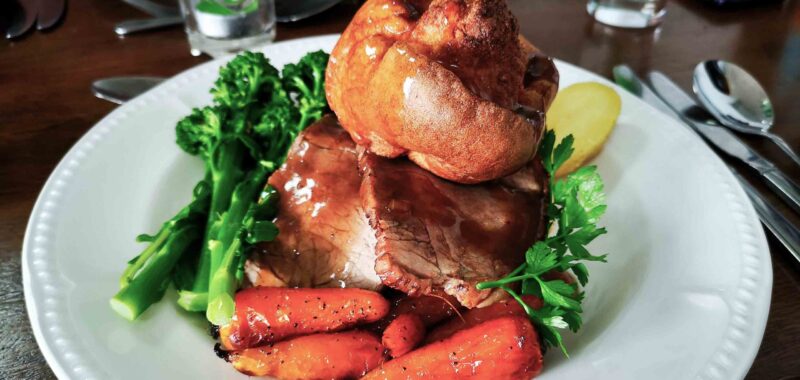
British food has never tantalized the tastebuds of the masses in the way that Italian, Japanese, Peruvian or, of course, French dishes have. But why not? Writer, comedian and pie afficionado Jon Holmes think there’s way more to British grub than meets the eye.
The soup splashes from ladle to bowl, dropped from ‘spattering height’ by a meat-fisted chef whose apron battles to contain his sizable frame while his chins spill down his neck, just as his weak broth is threatening to do onto the floor. He’s glaring at me, seemingly livid that I’ve dared to ask for seconds.
“More?” he bellows incredulously, causing the other diners to turn their heads. “You want some more?!” Or at least he would’ve done, if I hadn’t just made all this up.
That said, I’m confident tourists would flock to ‘Oliver’s’, as I’ve chosen to call my fictional café; a trendy, workhouse-themed pop-up in Hackney, East London which specializes in gruel—and given that’s what some non-Brits think epitomizes British cuisine, I’m sure it would be a hit. Also on the menu: Damp Yorkshire Pudding, boiled, leathery beef, and flaccid fish and chips. Pudding? Stodgy treacle sponge and custard, served cold. This is Britain, dammit, our diet is terrible.
Or is it?
Today, I say we can proudly hold our heads, knives, and forks aloft and claim our place on the foodie-podium—treacle sponge be damned. “It wasn’t that we didn’t have an abundance of ingredients,” Mike Denman, executive chef for D&D Restaurants tells me, when I ask him what the problem was, historically. “It’s that until about 20 years ago, no-one in Britain knew what to do with them.”
He goes on to list foods that he thinks Britain does better than anyone: Asparagus (“best in the world”), strawberries, vegetables, Scottish fish, North Sea lobster, scallops and so on. “And our climate means we have a lush, green countryside so our livestock is very well fed.” So, while we might also complain about the weather here, we do have it to thank for the grass that cows eat as they wait patiently to be made into steaks.
Their mission? To teach us an “understanding and love of food” and “play an educative role in developing British taste [in] a land of culinary philistines.” They changed the game (wild-meat pun absolutely intended), chefs became excited, farmers’ markets began to spring up, the middle classes got involved, home cooking evolved, and the rest—along with cheese and pineapple on cocktail sticks—is history.
These days, now we know what to do with it, we are rightly proud of our national foodie heritage. So much so in fact that we’ve pompously put place names in front of much of it: Lancashire hotpot, Cornish pasties, Devon clotted cream, the aforementioned Yorkshire pudding, Dorset crab, Whitstable oysters, Bakewell tart, Worcestershire sauce, Cheddar cheese, Dover sole, Cumberland pie, Eton mess, a Sandwich… the list goes on. Meanwhile, Scotch eggs, Welsh rarebits, and a full English breakfast get an entire country to their name.
And, yes, I am prepared to admit that the Romans had a historic crack at them too, but theirs was a pastry of flour, oil and water designed to preserve meat juices and was not intended to be eaten. No, it took guile, spirit, and good old-fashioned British ingenuity to make a main course with a fully consumable top, sides and bottom (aside: Pastry ‘toppers’ that sit loosely atop a filling do not maketh a pie. Far from being British, that is the Devil’s work).
And what is a Cornish pastie, if not just a pie with a handle? They were designed with that ribbed edge so that tin miners could eat them without getting arsenic all over their lunch. Food, with its own edible container, is nothing short of a masterpiece of gastronomical manufacturing. And because UK manufacturing needs a post-Brexit lift, I’m happy to do my bit by committing to a regular pie order so I don’t even have to leave my house to enjoy them… I even use the same company to send pies to friends as presents, for who among us would not appreciate the gift of British pie?

